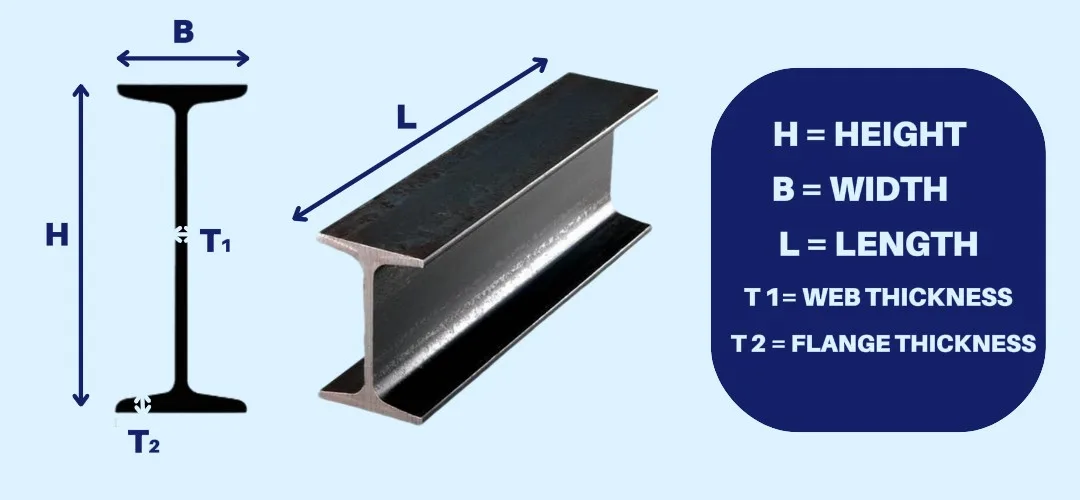
An I-beam, also known as a universal beam (UB), H-beam, or rolled steel joist (RSJ), is a structural steel member with an “I” or “H” shaped cross-section.
It is widely used in construction and engineering due to its high strength-to-weight ratio. The vertical section is called the web, which resists shear forces, while the horizontal sections are flanges, designed to resist bending.
Knowing the weight of an I-beam is crucial for:
Estimating structural load
Planning transportation and lifting
Calculating cost based on material weight
Structural design and analysis
This is where the I-Beam Weight Calculator becomes an indispensable tool.
An I-Beam Weight Calculator is an online tool that helps engineers, fabricators, and students quickly and accurately estimate the weight of an I-beam based on input dimensions and material type.
The tool simplifies the traditionally complex calculations into a few simple steps, delivering results in kilograms, pounds, tons, and grams.
Here are some reasons why this tool is widely preferred:
Saves Time: Instant calculation without manual formulas.
User-Friendly: Easy to input dimensions and select units.
Multi-Unit Output: Supports both metric and imperial units.
Versatile Material Support: Includes steel, aluminum, copper, brass, etc.
The calculator supports a wide range of units such as:
Millimeters (mm)
Centimeters (cm)
Meters (m)
Inches (in)
Feet (ft)
All input dimensions are internally converted to meters for consistency.
The tool allows selection from various materials with standard densities:
Mild Steel
Stainless Steel
Aluminum
Carbon Steel
Copper
Brass
Titanium
Cast Iron
Tool Steel
Lead
Bronze
This ensures accurate weight estimation for any material type.
Results are shown in:
Kilograms (kg)
Pounds (lbs)
Metric Tons
Grams (g)
This multi-unit output helps in different phases of engineering—from procurement to shipping and installation.
To use the I-Beam Weight Calculator, enter the following:
Height (H) – Total height of the beam
Width (B) – Width of the flange
Web Thickness (t₁) – Vertical section thickness
Flange Thickness (t₂) – Horizontal flange thickness
Length – Length of the I-beam
Material – Select from dropdown based on density
The calculator uses the standard formula:
Weight = [(H × t₁) + 2 × (B × t₂) − 2 × (t₁ × t₂)] × Length × Density
This formula accounts for overlapping parts at flange-web intersections, providing accurate cross-sectional area and thus precise weight.
Structural engineers use the I-Beam Weight Calculator to size and plan beams for buildings, bridges, and industrial structures. Accurate weight helps in load calculations and foundation design.
Fabricators use it to estimate the raw material required and the handling equipment for cutting and welding operations.
Knowing the weight of an I-beam is crucial for arranging cranes, trucks, and shipping containers.
Manual calculations are prone to error and time-consuming. This tool delivers instant and precise weight outputs.
Responsive design makes it accessible from mobile devices, tablets, and desktops alike.
Even beginners in engineering or construction can use the I-Beam Weight Calculator without prior experience.
It’s available online and doesn’t require login, subscription, or any special software to use.
This calculator is a valuable resource for:
Civil and Structural Engineers
Mechanical Designers
Fabrication Shops
Architects and Builders
Engineering Students
Procurement Professionals
Yes, the calculator supports custom dimensions and unit conversions for universal applicability.
Densities are based on industry standards but should be verified if precision is critical to your project.
This calculator assumes solid I-beam sections. For hollow profiles, adjust the area formula accordingly.
The I-Beam Weight Calculator is an essential tool in today’s fast-paced engineering world. It combines speed, accuracy, and versatility in one compact interface.
Whether you’re estimating the weight of a structural component or planning logistics for a construction project, this tool saves time, reduces error, and increases productivity.
Explore the Engineer’s Guidebook! Find the latest engineering tips, industry insights, and creative projects. Get inspired and fuel your passion for engineering.
© 2023-2024 Engineer’s Guidebook. All rights reserved. Explore, Innovate, Engineer.